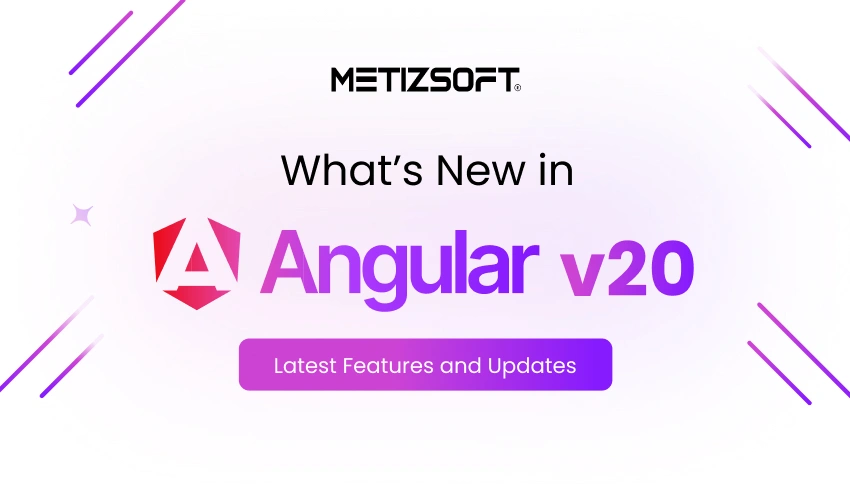
Table of Contents
Introduction
Angular 20, released on 29th May 2025, is exciting news for developers and enterprises investing majorly in modern web applications. The Angular framework introduces a refined reactivity model, performance enhancement, and developer-centric features in this latest version. The community hopes that the Angular 20 features will help developers, project managers, and CTOs to quickly build the next generation of web applications with robust performance.
This blog post delves into the latest updates and features of Angular 20. Whether you are a startup, tech enthusiast, or freelancer, you must adhere to the detailed outline here and plan a successful Angular 20 implementation in your next project.
Key Features in Angular 20
Angular 20 introduces many game-changing features that can improve performance significantly, enhance the developer experience, and modernize web development practices. If you want to benefit from these features in your next projects, then hire Angular developers from a reliable source. Discuss the smooth implementation of these features into your next Angular projects.
Here’s a comprehensive overview of the primary updates and features of Angular 20:
Support for Gen AI Development
Angular is actively investing in initiatives to ensure that Large Language Models (LLMs) can produce accurate, modern Angular code. This effort also aims to equip developers with the necessary resources to build applications using Generative AI (GenAI).
- Modernizing LLM Output with llms.txt: To address the challenge of LLMs generating outdated Angular syntaxes, such as legacy directives or NgModules, an llms.txt file is now available within Angular.
- Resources for Building AI-Powered Angular Apps: Angular provides practical resources to assist developers in building GenAI-powered applications. These resources include live demonstrations integrating Genkit and Vertex AI and open-source sample projects.
Incremental Hydration (SSR)
Angular 20 introduces significant advancements in Server-Side Rendering (SSR), particularly with incremental hydration. It will now allow components to hydrate as needed. Key improvements are made by stabilizing the I18nSupport() and incremental hydration() APIs. Additionally, the CLI now generates servers using Express v5, with corresponding updates to the server code.
For a more streamlined SSR setup, the provideServerRendering() and provideServerRoutesConfig() APIs have been merged into a single API: provideServerRendering(withRoutes()). These are moved to the @angular/ssr package. The simplification extends to the CLI, where the –server-routing flag has been removed; –ssr now includes routing by default. It makes the configuration for SSR simpler and more efficient for developers.
Zoneless Change Detection (Experimental)
Angular 20 introduces the experimental ability to run applications without Zone.js. In this new approach, developers utilize signals and event-based reactivity to manage change detection in a more controlled and optimized manner.
When you update to a zoneless application, it will reduce the bundle size and improve performance. You can achieve this by eliminating global patches and unnecessary change detection cycles. Furthermore, debugging is simplified with cleaner stack traces. This makes identifying and resolving issues within your Angular applications easier.
Enable zoneless mod with the following code:
bootstrapApplication(AppComponent, {
providers: [provideZoneChangeDetection({ enabled: false })],
});
Stabilized APIs
A significant update in Angular v20 is the stabilization of effect, linkedSignal, and toSignal. The Angular team continues to focus on Signals as they are considered the future of Angular’s reactivity model. It’s important to note that afterRender() has been renamed to afterEveryRender() without backward compatibility.
This version improves testing as TestBed.flushEffects() is deprecated in favor of TestBed.tick(), which performs a full synchronization. They have removed some alternatives, such as force root and rejectors, for simplicity. In addition, the RXJS operator has been transferred from the pending () to the preview for the developer. This indicates the progression of angular activity facilities.
For Instance:
import { signal, effect } from ‘@angular/core’;
const name = signal(‘Angular’);
effect(() => console.log(`Name changed to: ${name()}`));
name.set(‘Angular 20’);
// Output: Name changed to Angular 20
Resource APIs
Angular 20 introduces new resource() APIs. It will specifically simplify asynchronous data handling. These APIs simplify complex data flows by providing built-in caching, robust error handling, and intuitive loading states.
Key Enhancements:
A notable addition is httpResource(), an experimental API that allows developers to make HTTP requests using a Signal-based reactive model. Some refinements are in place for enhanced clarity and control within these experimental APIs.
- The query parameter in resource() is now “params”.
- The loader in rxResource() is now “stream”.
- Additionally, you can add only mutable resources to enhance predictability in data management.
For Instance:
const userId: Signal = getUserId();
const userResource = resource({
params: () => ({id: userId()}),
loader: ({request, abortSignal}): Promise => {
// fetch cancels any outstanding HTTP requests when the given `AbortSignal.`
// indicates that the request has been aborted.
return fetch(`users/${request.id}`, {signal: abortSignal});
},
});
Better Integration With PaaS
Angular 20 provides improved integration with popular Platform as a Service (PaaS) providers such as Heroku, AWS Elastic Beanstalk, and Google App Engine. The deployment process to these platforms has been significantly simplified by introducing the new Angular Deploy tool.
Signal-Based Forms
Angular 20 is bringing signal-based forms, which offer a more reactive and declarative way to manage forms. Currently, in the developer preview stage, these forms are moving away from traditional event listeners and changing detection cycles. Instead, they use reactive primitives that automatically track and react to changes. This makes the form-state management more efficient. This new approach provides many benefits, including:
- Low boilerplate
- Better scalability for complex forms
- Real-time updates and faith
For Instance:
const username = signal(”);
const form = signalFormGroup({
username: signalFormControl(username),
});
Chrome DevTools Integration
Angular 20 updates bring major improvements to the debugging and performance profiling workflow through its deeper integration with Chrome DevTools. This means developers can access Angular-specific profiling data directly within the Chrome Performance tab.
This integration provides valuable insight into application performance, component rendering cycle, and detection of change. As a result, it has become easier to identify performance problems. In addition, they have simplified the adaptation process.
Improved Built-in Control Flow
Angular 20 increases the adoption of its new built-in control flow syntax. It was initially introduced in Angular v17. This modern syntax, which includes directives like @if, @for, and @switch, offers a more intuitive, JavaScript-like approach to templating.
Given the strong community adoption, with over half of Angular v17+ applications already utilizing the new syntax, the older ngIf, ngFor, and ngSwitch structural directives are now being deprecated. Developers are encouraged to migrate their code using the convenient ng generate @angular/core:control-flow schematic.
Note: These deprecated directives may be removed in future versions, potentially as early as v22, making early migration a proactive step for long-term project health.
Improved Developer Experience
Angular’s official style guide is continuously refined. It promotes consistent, readable, and maintainable code that’s integrated with tooling for easier adoption. As a result, developers now benefit from robust type checking and improved IDE assistance for host bindings. Specifically, it offers better auto-completion, real-time validation, and early error detection to reduce runtime errors.
Furthermore, support for untagged template literal expressions in templates is a new capability that allows direct use of standard JavaScript template literals (e.g., `Hello ${name}!`) within Angular templates. It provides greater flexibility for dynamic string creation.
Finally, Template Hot Module Replacement (HMR) is now a default feature in Angular 20. It enables near-instant UI updates in the browser without full page reloads or loss of application state, which significantly speeds up the development loop.
How Can You Upgrade to Angular 20?
Before you dive straight to upgrade to the latest Angular version- Angular 20, double-check the pre-upgrade checklist to save time and effort:
- Securely back up your project data to safeguard your work against any unforeseen issues that might arise during the upgrade process.
- Maintain a clean git status; commit all changes to prevent conflicts.
- Update Node.js to v20 (the latest Long Term Support – LTS – version) and npm/Yarn for optimal compatibility and performance.
- Address existing warnings or issues to stabilize the starting point. It minimizes the likelihood of new issues emerging after the upgrade.
- Ensure application stability to confirm your app functions correctly before any significant changes.
- Verify TypeScript compatibility so that dependencies align with the Angular upgrade requirements. It will prevent compatibility issues.
Now, let’s dive into the Angular 20 update steps:
Step 1: Update Global Angular CLI
Uninstall the previous global CLI to install the latest:
npm uninstall -g @angular/cli
npm install -g @angular/cli@latest
Step 2: Update Your Project
- Move through to your project folder.
- Run the update command. If you’re using an older version (e.g., v17, 18), update one major version at a time.
cd your-angular-project
ng update @angular/cli @angular/core –next
Important: Read the command line interface (CLI) output carefully. This output will highlight specific migrations or breaking changes.
Step 3: Install Dependencies
Once the ng update completes, refresh your node_modules:
npm install (or yarn install)
Step 4: Run test and Fix Issues (if any)
Once you update your Angular project, thoroughly test the application to ensure everything works as expected. Hire Angular developers to conduct multiple tests and resolve issues before launch.
- Once the Angular 20 update is complete, run your application using ng serve. It is to verify application functionality!
- To ensure the integrity of your code, operate your tests using ng test (including end-to-end or E2E tests).
- Compilation errors, runtime issues, or test failures commonly occur during the transition. Hence, follow the official Angular Update Guide for detailed information on specific breaking changes and comprehensive migration details relevant to your version jump.
Key Benefits of Angular 20 Updates
- Enhanced Performance: Angular applications are designed for robust performance. This means they load quickly and function memory-efficiently. We largely assign this to advancements in the Ivy compiler and improvements in reactivity.
- Boosted Developer Productivity: Angular has improved the development experience. The newly updated CLI commands and superior TypeScript support work together to create a more efficient and streamlined workflow for developers.
- Simplified Deployment: The deployment of Angular applications is easier than ever. This is due to better integration with PaaS (Platform as a Service) providers. Moreover, the introduction of the Angular Deploy tool simplifies the entire deployment process.
- Fortified Security: Security is a paramount concern! Angular addresses this with robust, built-in protections against common web vulnerabilities. Additionally, Content Security Policy (CSP) support is there to further bolster application security.
Are You Ready to Switch to Angular 20?
Angular 20 features and updates can prove to be a game-changer for developers. That’s because the newly involved smart tools and facilities prepared for the future will perform faster. It will simplify complex development processes and improve the quality of Angular applications. With exciting advancements across signals, forms, AI integration, and Server-Side Rendering (SSR), this version sets a new benchmark for creating scalable and modern web experiences. Ultimately, this upgrade of the Angular version will build a robust foundation for future web application development.
If you need assistance with the Angular 20 upgrade process or have questions, connect with an Angular development company with a higher reputation!
AboutChetan Sheladiya
Related Posts
The Whole New Laravel 6.0 has Been Released! Here’s Everything you Need to Know About it
Laravel, as we know, is quite popular and for all the right reasons. It is a free, open-source PHP web framework for...
What’s New in Node.js 22? Exploring the Latest Features & Updates
Table of Contents IntroductionNode.js 22 has arrivedNode.js 22: Latest Features & UpdatesFinal Takeaway! Introduction...

